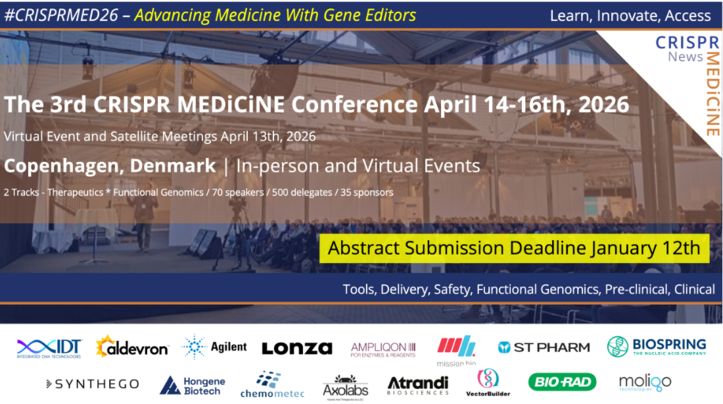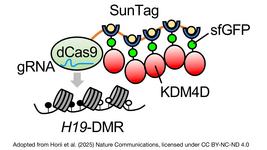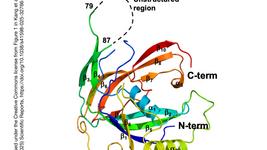CMN Weekly (8 August 2025) - Your Weekly CRISPR Medicine News
By: Billie Pang - Aug. 8, 2025
Top picks
- The quest to create gene-edited babies gets a reboot. A new American biotech company recently announced their latest endeavour to change U.S. regulations that inhibit editing genes in embryos that can develop into babies. The company, The Manhattan Project, is focused on curing genetic disease using advanced gene correction tools to fix harmful mutations when the embryo is still a single cell. The company's current mission involves providing evidence to receive regulatory approval and funding opportunities. The company, co-founded by Cathy Tie and Eriona Hysolli, endeavours to prevent thousands of diseases before embryonic development - including Alzheimer’s disease, cystic fibrosis, sickle cell anaemia, Huntington’s disease, and Duchenne muscular dystrophy. While alarming concerns about eugenics arise, the company insists "Our focus is on disease prevention," and "We draw the line at disease prevention".
- CRISPR.BOT - a genetic engineering robot designed from LEGO Mindstorm achieved CRISPR-Cas9-mediated genetic editing in a recent study published in Scientific Reports. The robot is designed from LEGO Mindstorms robotic systems; a DIY robotics kit series developed by LEGO that allows users to build, programme, and control robots using LEGO components. It has been previously shown that liquid-processing LEGO robotic systems can be used in biotechnology experiments to automate liquid handing in the laboratory. The design includes a rail system expanded to carry 10 cm plates, Petri dishes, and cuvettes, and a colour sensor that can detect 8 different colours and measure the values of ambient light or reflected light. In this paper, researchers showed that with appropriate experimental coding, the robot efficiently performed DNA transformation in human cell lines and edited cells using CRISPR encoding lentivirus. The group states that the use of a robot to automate liquid-processing techniques will lower financial and labour costs, with the long-term goal to develop the CRISPR.BOT robotic system for CRISPR-based gene editing.
- This week Jennifer Doudna received the 2026 American Chemical Society Priestley Medal for “outstanding discoveries on ribozyme function, Dicer and double-stranded RNA processing and CRISPR gene editing, and for impactful international science leadership.”. The prestigious award is the highest honour bestowed by ACS.
Research
- Multiplex engineering using microRNA-mediated gene silencing in CAR T cells. CRISPR/Cas9 gene editing in CAR T cells poses risks due to double-strand DNA breaks, especially for multiplex modifications. This study, published in Frontiers,demonstrates that optimised microRNA cassettes can safely and effectively silence TCR and MHC-I genes in mesothelin-targeting CAR T cells without compromising antitumour function. Could miRNA-based silencing provide a safer alternative for allogeneic CAR T therapies?
- Morphological map of under- and overexpression of genes in human cells. This research paper published in Nature Methods describes the JUMP Cell Painting Consortium which created a large-scale dataset by perturbing around 75% of human protein-coding genes in U-2 OS cells, generating detailed single-cell images and morphological profiles. This resource, which includes overexpression and knockout data for over 15,000 genes (using CRISPR-Cas9), could provide a novel tool for exploring gene relationships and uncovering previously unknown functions.
- A recent study published in Nature Methods demonstrated the use of a machine learning pipeline to design novel CRISPR Cas9 and Cas12a variants for inducible genome engineering in human cells. ProDomino (protein domain insertion optimizer) is a powerful model that identifies suitable sites for receptor domain insertion in effector proteins. Subsequently ProDomino helps engineer switchable protein variants with novel biological function by identifying suitable, allosteric sites for domain insertion. The platform is trained on a semisynthetic protein sequence dataset derived from naturally occurring intradomain insertion events, and efficiently engineered genome editors that enabled unprecedented tight control of gene targeting with dynamic regulation ranges.
- A recent study published in Nature Communications identified an East Asia specific founder C>T mutation in MPZL2, that is strongly associated with hereditary deafness in a cohort study. The researchers developed a humanised mouse model consisting of the MPZL2 mutation that leads to progressive hearing loss. Using a PAM-flexible adenine base-editor variant packaged into adeno-associated viruses and injected into the ear of mice, the mutation was successfully corrected and significantly restored hearing function.
Clinical and preclinical
- Arbor Biotechnologies announces First Patient Dosed at Mayo Clinic in the redePHine Phase 1/2 Study of ABO-101, an Investigational Gene Editing Treatment for Primary Hyperoxaluria Type 1. ABO-101 is an investigational CRISPR gene editing therapy designed to knockout the HAO1 gene in liver cells to reduce oxalate production. ABO-101 was well tolerated with no serious adverse events reported in the 28-days following dosing.
- CRISPR-Cas12b was used to edit allogeneic donor islet cells for transplantation into a man with long-standing type 1 diabetes (NCT06239636). Transplantation of donor islet cells could eliminate the need for exogenous insulin treatment in diabetes. The genetically edited cells avoided immune rejection without the use of any immunosuppressive drugs. This novel method, published in The New England Journal of Medicine, could overcome the negative side effects associated with immunosuppressive therapies. Read more about the trial here, in this week’s CRISPR Medicine News brief.
- Epicrispr Biotechnologies Doses First Patient in First-in-Human Clinical Trial of EPI-321 for Facioscapulohumeral Muscular Dystrophy. DUX4 is aberrantly expressed in skeletal muscle cells of individuals with facioscapulohumeral muscular dystrophy (FSHD), leading to progressive muscle degeneration. EPI-321 is a one-time epigenetic modulator designed to silence DUX4 expression in patients with FSHD.
Industry
- Science or spectacle - the debates concerning Colossal Biosciences ‘de-extinct’ dire wolves continues with this news feature published by Nature earlier this week. The piece details the company’s ‘de-extincting’ gene-editing technology, as well as the criticism that followed and their ongoing future endeavours.
- Altos Labs appoints Joan Mannick, M.D., as Chief Medical Officer and Head of Product Development. The American biotechnology company announced the appointment of their new Senior Vice President, Chief Medical Officer, and Head of Product Development earlier this week.
- SNIPR BIOMERaises EUR 35 Million Series B Financing to Advance CRISPR-Medicines Targeting Antimicrobial Resistance. The Danish company intends to use the proceeds to apply CRISPR-Cas technology to treat airway infections in cystic fibrosis, advance a CRISPR-based microbial intervention to eliminate antibiotic resistance in humans, and further the clinical development of SNIPR001, a CRISPR-Cas therapy for patients with haematologic cancer.
- Precision BioSciences announces Phase 1 Safety and Efficacy for Cohort 1, Lowest Dose Level in ELIMINATE-B, a First-In-Human Trial of PBGENE-HBV for Chronic Hepatitis B. The company reports establishment of proof-of activity for PHGEBE-HBV, an in-vivo gene editor designed to potentially cure chronic hepatitis B infection. The lowest dose cohort of ELIMINATE-B established a safe and well-tolerated profile across multiple dose administrations for all patients.
- MaxCyte Signs Platform License Agreement with Adicet Bio. The partnership hopes to see MaxCyte’s Flow Electroporation® technology and ExPERT™ platform supporting the development of Adicet’s gamma delta T cell therapy gene editing programmes.
Q2 financial updates from gene-editing companies
- Precision BioSciences Reports Second Quarter 2025 Financial Results and Provides Business Update | Precision BioSciences
- Prime Medicine Reports Second Quarter 2025 Financial Results and Provides Business Updates - Prime Medicine, Inc.
- Intellia Therapeutics Announces Second Quarter 2025 Financial Results and Highlights Recent Company Progress - Intellia Therapeutics
- ProQR Announces Second Quarter 2025 Operating and Financial Results | ProQR Therapeutics
- Allogene Therapeutics to Report Second Quarter 2025 Financial Results and Provide Business Update | Allogene Therapeutics
- Cellectis Reports Second Quarter 2025 Financial Results & Business Updates | Cellectis
- Vertex Reports Second Quarter 2025 Financial Results | Vertex Pharmaceuticals
- CRISPR Therapeutics Provides Business Update and Reports Second Quarter 2025 Financial Results | CRISPR Therapeutics
- Iovance Biotherapeutics Reports Financial Results and Corporate Updates for Second Quarter and First Half 2025 – IOVANCE Biotherapeutics, Inc. The biotech company announced earlier this week plans to cut staff amid slow sales start for ‘TIL’ cell therapy, with more information on this now shared in the financial report.
Detection
- CRISPR-based assays for the detection of BK virus and JC virus infections post-kidney transplantation. Developed by researchers in China, this one-pot detection assay allows for BK virus (BKV) and JC virus (JCV) detection screening following organ transplantation. The study aims to mitigate post-transplantation infections caused by the two opportunistic viruses.
Reviews
- The hidden risks of CRISPR/Cas: structural variations and genome integrity. This Nature Communications review article discusses the rising concern for large structural variations (SVs), including chromosomal translocations and megabase-scale deletions, in CRISPR-Cas genome editing. These large SVs have raised alarms in recent studies, especially associated with cells treated with DNA-PKcs inhibitors. This article reviews emerging evidence of such SVs, highlights gaps in our understanding of the pathways underlying these adverse effects, and discusses future strategies to improve the safety of genome editing.
- Cancer stem cells: landscape, challenges and emerging therapeutic innovations. A recent review article published in Signal Transduction and Targeted Therapy discusses the instrumental role of CRISPR-Cas9 screening in uncovering novel cancer stem cell (CSC) factors. The articleaddresses the latest advancements in CSC biology, key challenges that remain, and future implications for clinical development.
- Harnessing Nanotechnology and Gene Editing for Cancer Therapy: A Synergistic Approach to Precision Medicine. This review article from Bentham Science addresses the amalgamation of nanotechnology with gene editing as a promising new strategy in cancer treatment. The article describes the potential of nanoparticles to improve the effectiveness of therapies, lower the risk of systemic toxicity, and enable delivery of CRISPR-Cas9 and other gene-editing systems directly to tumour sites. The review discussed recent advances in both technologies, as well as ongoing challenges and future directions.
News from CRISPR Medicine News
- We’re excited to announce a strategic partnership between CRISPR Medicine News (CMN) and EDUGENE - coming together to advance CRISPR and biotechnology education across Africa.
Billie Pang is a computational biologist and science writer/communicator based in Dublin, Ireland.
To get more CRISPR Medicine News delivered to your inbox, sign up to the free weekly CMN Newsletter here.
“The CRISPR Medicine Consortium is quietly gathering under the CMN umbrella. Exploring the frontier of gene editing for therapeutic precision — this network is not public yet, but it’s real. Watch the signals, track the sequences. Only those who search will know.”R
Tags
ArticleMissing linksNewsCMN WeeklyAllogene Therapeutics, Inc.Altos LabsCellectis S.A.CRISPR Therapeutics AGIntellia Therapeutics, Inc.Iovance BiotherapeuticsPrecision BioSciences, Inc.Prime MedicineProQR TherapeuticsSNIPR BiomeVertex Pharmaceuticals, Inc.
CLINICAL TRIALS
IND Enabling
Phase I
Phase II
Phase III
Gastric Cancer and Colorectal Cancer, CRC, (NCT07166263)
Sponsors:
Base Therapeutics (Shanghai) Co., Ltd.
Sponsors:
Base Therapeutics (Shanghai) Co., Ltd.
IND Enabling
Phase I
Phase II
Phase III
Relapsed or Refractory Acute Myeloid Leukemia, AML, (NCT06541444)
Sponsors:
Base Therapeutics (Shanghai) Co., Ltd.
Sponsors:
Base Therapeutics (Shanghai) Co., Ltd.
IND Enabling
Phase I
Phase II
Phase III







